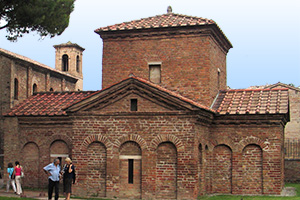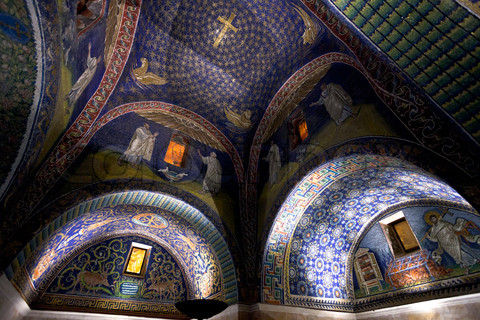The Empress and her Mausoleum

This year, the Townsend Blog will feature a series of posts from members of its Working Groups. Founded in 1994, the Late Antique Religions et Society (LAReS) Working Group focuses on Late Antiquity, a dynamic period in the history of Europe, the Near East, and North Africa that spans from the third century to the eighth century AD. In this post, Susanna Elm, Professor of History and Classics, meditates on Galla Placidia, an overlooked ruler of the Western Roman Empire.

Rome's Castel Sant' Angelo is majestic, especially
compared to the Galla Placidia in Ravenna.
The mausoleum of Galla Placidia in Ravenna, on Italy’s Adriatic coast, can tell us much about the fate of Italy in the later phases of the Roman Empire. Small and unprepossessing on the outside, the mausoleum stands in stark contrast to the splendors of Rome. This is not Rome’s majestic Castel Sant’Angelo, which began as emperor Hadrian’s mausoleum before it became, among other things, a papal residence and a location for the dramatic end of Puccini’s opera Tosca. Yet despite its relative modesty, especially when compared to Rome, Ravenna was an imperial residence and Galla Placidia was an empress. She and the mausoleum carrying her name deserve a second look.
More than just an empress, Galla Placidia was an actual ruler of the Western Roman Empire as regent for her son Valentinian, who became emperor at the tender age of five. His sarcophagus, together with that of her second husband, Constantius, and that of her brother, Honorius, are said to be inside the mausoleum, though it is not actually confirmed whose remains those sarcophagoi contain. No matter who was buried in those sarcophagoi, in life Galla Placidia was the most interesting of them all. Her second husband, a general, had died by the time her son became emperor and she his regent, and by then she had learned a few things about Realpolitik.
Born around 390 in Constantinople as daughter of the emperor Theodosius I, Galla Placidia had been married before: captured during the sack of Rome in 410 by the Visigothic leader Alaric, she was married to his successor Athaulf in 414 as part of a complex set of peace negotiations. To be captured by barbarians during acts of war was the equivalent of enslavement, and those who held her knew what they could demand for the ransom of an imperial princess—settlements and lands in Roman Spain. These negotiations took two years. In 416 Galla was returned, after the death of the son she bore Athaulf and his own death through murder, only to be forced to marry the general who had pressured the Visigoths into releasing her: Constantius, he who may or may not have been buried in her mausoleum.
Barbarian captivity, pawn in settlement negotiations, forced marriages—still no reason to think of Galla Placidia as merely the victim of her circumstances. By all accounts, she never forgot that she was the daughter and the sister of Roman emperors, married to men who were by no means her equal. Thus, the historian Zosimus stresses that even the Visigoths who held her captive took pains to show her all the deference due a Roman imperial princess. Of course, later historians held her personally responsible for the failures of the besieged empire and those of her son, whom she is said to have spoiled rotten. But as de facto ruler of the West, Galla Placidia fought valiantly for her independence while caught between feuding generals, advancing Visigoths, Vandals, and Huns. Much like the mausoleum carrying her name, she deserves our close attention.

Indeed, the mausoleum, with its unassuming exterior, reveals its true splendor only once you step inside. It is covered in mosaics like a glittering jewel-box, a truly wonderful sight. In fact, it is not certain that Galla Placidia was buried there. She died in Rome in 450, on the eve of the second sack of that city in one and the same century, and that is where she was probably buried. Nevertheless, it is the mausoleum in Ravenna that remains indelibly associated with her name, its hidden beauty intact and preserved for all to see as a UNESCO world heritage site.
Image Credits:
Exterior of the Galla Placidia Masoleum
The Castel Sant' Angelo
Mosaic of the Galla Placidia Masoleum